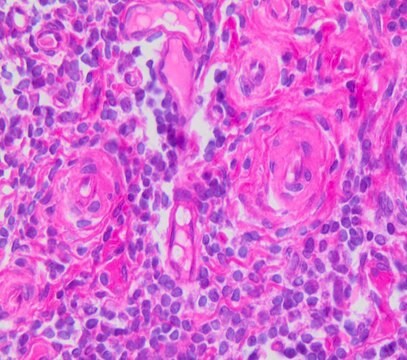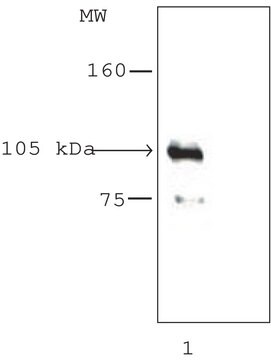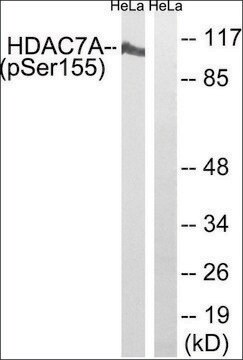Wichtige Dokumente
H6663
Anti-Histone Deacetylase 7 (HDAC7) antibody, Mouse monoclonal
clone HDAC7-97, purified from hybridoma cell culture
Synonym(e):
Anti-HDAC7
About This Item
Empfohlene Produkte
Biologische Quelle
mouse
Qualitätsniveau
Konjugat
unconjugated
Antikörperform
purified from hybridoma cell culture
Antikörper-Produkttyp
primary antibodies
Klon
HDAC7-97, monoclonal
Form
buffered aqueous solution
Mol-Gew.
antigen ~105 kDa
Speziesreaktivität
human, mouse
Methode(n)
immunocytochemistry: suitable
immunoprecipitation (IP): suitable
indirect ELISA: suitable
microarray: suitable
western blot: 0.25-0.5 μg/mL using recombinant protein from embryonal kidney 293T cells over-expressing human HDAC7
Isotyp
IgG1
UniProt-Hinterlegungsnummer
Versandbedingung
dry ice
Lagertemp.
−20°C
Posttranslationale Modifikation Target
unmodified
Angaben zum Gen
human ... HDAC7(51564)
mouse ... Hdac7(56233)
Allgemeine Beschreibung
Anwendung
- chromatin immunoprecipitation
- immunoblotting
- immunocytochemistry
- immunoprecipitation
- ELISA
- immunocytochemistry
- immunoprecipitation
- indirect ELISA
- microarray
- western blot at a concentration of 0.25-0.5μg/mL using cell extracts of human embryonal kidney 293T cells expressing recombinant human HDAC7
Biochem./physiol. Wirkung
Physikalische Form
Haftungsausschluss
Sie haben nicht das passende Produkt gefunden?
Probieren Sie unser Produkt-Auswahlhilfe. aus.
Lagerklassenschlüssel
10 - Combustible liquids
WGK
nwg
Flammpunkt (°F)
Not applicable
Flammpunkt (°C)
Not applicable
Hier finden Sie alle aktuellen Versionen:
Besitzen Sie dieses Produkt bereits?
In der Dokumentenbibliothek finden Sie die Dokumentation zu den Produkten, die Sie kürzlich erworben haben.
Unser Team von Wissenschaftlern verfügt über Erfahrung in allen Forschungsbereichen einschließlich Life Science, Materialwissenschaften, chemischer Synthese, Chromatographie, Analytik und vielen mehr..
Setzen Sie sich mit dem technischen Dienst in Verbindung.







